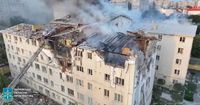As dawn broke over Kharkiv on August 18, 2025, the city’s familiar skyline was obscured by smoke and debris. A Russian drone strike, one of the deadliest in recent months, had just torn through a residential building, killing at least seven people, including a toddler and a 16-year-old. The attack, which local authorities say was carried out by five Shahed drones, also injured 20 people, among them six children. The devastation left entire families shattered—one family, living on the fifth floor, perished together in their apartment, according to Serhiy Bolvinov, head of the Kharkiv National Police's investigations unit, as reported by ABC News.
This was not an isolated incident. Overnight, Russia launched a staggering 140 drones and four missiles across Ukraine, targeting 25 locations in regions including Donetsk, Kharkiv, Sumy, Dnipropetrovsk, Odesa, and Kyiv. Ukraine’s air force reported that 88 of the drones were shot down or suppressed, but the remainder found their marks in residential neighborhoods and public spaces. The southern region of Zaporizhzhia was also hit hard, with at least three killed and 23 injured by missile strikes, as confirmed by Governor Ivan Fedorov. In Donetsk, ongoing ground fighting claimed five more lives and left four injured, according to local officials cited by Al Jazeera.
The timing of these attacks was, by many accounts, deliberate. They came on the eve of a high-stakes summit in Washington, D.C., where Ukrainian President Volodymyr Zelenskyy was set to meet U.S. President Donald Trump and a cohort of European leaders. The agenda: a potential peace deal that could determine Ukraine’s future and possibly the fate of the war, now entering its fourth year. Zelenskyy, speaking from Washington, described the attacks as “demonstrative and cynical.” On his Telegram channel, he wrote, “Putin will commit demonstrative killings to maintain pressure on Ukraine and Europe, as well as to humiliate diplomatic efforts.” He went on to stress the urgency of reliable security guarantees, stating, “That is why Russia must not receive any reward for this war. The war must be ended. And it is Moscow that must hear the word ‘stop’.”
Andriy Yermak, Zelenskyy’s influential chief of staff, echoed these sentiments. “That’s why Putin doesn’t want to cease fire,” he wrote on Telegram, as reported by Fox News. “He enjoys shelling peaceful cities while talking about his desire to end the war.” Kharkiv’s mayor, Ihor Terekhov, described the drone strike as a “deliberate” attack, noting that the drones approached from different directions and struck while people were sleeping at five in the morning. Video footage released by local authorities captured the harrowing aftermath: collapsed upper floors, smoke billowing from the ruins, and firefighters desperately searching for survivors—one image showed a firefighter carrying the lifeless body of a child.
For Zelenskyy, the attacks underscored the stakes as he entered negotiations with Trump and European Commission President Ursula von der Leyen. The meeting, held at the White House, was attended by several heavyweight European leaders, all intent on forging a path to peace. On the table were sensitive issues: security guarantees for Ukraine, humanitarian aid, prisoner exchanges, and the ever-contentious question of territorial concessions. According to Al Jazeera, Zelenskyy made it clear that while he was open to discussing security and humanitarian measures, any discussion of ceding Ukrainian territory would be reserved for a trilateral meeting with Russian President Vladimir Putin. Such concessions remain forbidden under Ukraine’s constitution, and Zelenskyy has so far refused to consider them.
The diplomatic backdrop was fraught with tension. Just days earlier, Trump had met with Putin in Anchorage, Alaska, in a summit that ended without a clear breakthrough. Trump, ahead of the meeting, stated he would be “unhappy” if Putin did not agree to a ceasefire. While no ceasefire emerged, Trump claimed progress on several fronts. For Ukraine, the pressure to negotiate has grown as Russia has made incremental gains on the battlefield—particularly in the eastern Donetsk region. “At the moment, Russia is advancing on the ground. Slowly, but faster than it has been for some time. It is Ukraine that is being pushed back,” said Anatol Lieven, an analyst at the Quincy Institute for Responsible Statecraft, as reported by Al Jazeera. Lieven noted that Russia’s battlefield successes reduce its incentive to agree to a ceasefire absent a comprehensive peace agreement.
Despite the carnage, Ukrainian forces have not remained idle. On the same day as the Kharkiv attack, the Ukrainian military struck an oil-pumping station in Russia’s Tambov region, causing a fire and halting supplies through the Druzhba pipeline. Four people were injured in Russia’s Belgorod region in a Ukrainian drone attack, and air raid sirens sounded over Kyiv as a Russian MiG-31—capable of carrying Kinzhal hypersonic missiles—was detected overhead, according to reports from AFP and Ukraine’s air force.
The scale of violence in Ukraine has been staggering. According to the United Nations’ Human Rights Monitoring Mission, July 2025 was the deadliest month for Ukrainian civilians since May 2022, with at least 286 killed and 1,388 injured. The Ukrainian air force reported that Russia launched a record 6,443 drones and missiles in July alone—a daily average of 201 drones and six missiles. The barrage has continued into August, though at a somewhat reduced pace: as of August 18, Ukraine had recorded 1,344 drone and 27 missile launches by Russia this month, averaging about 74 drones and more than one missile daily. Russia claims to have shot down 1,740 Ukrainian drones in August, at a rate of 96 per day.
For ordinary Ukrainians, the statistics are more than numbers—they are a daily reality of fear, loss, and resilience. The attacks on Kharkiv and other cities serve as a grim reminder of the war’s human toll. As Zelenskyy told Trump at the White House, “We need to stop this war, to stop Russia. And we need support, American and European partners. We will do our best for this.”
The world watched as Zelenskyy and his allies pressed for meaningful security guarantees and a durable peace. But with Russia showing little sign of relenting, and with battlefield dynamics shifting, the path forward remains uncertain. What is clear is that the stakes—for Ukraine, for Europe, and for the broader international order—have never been higher.


